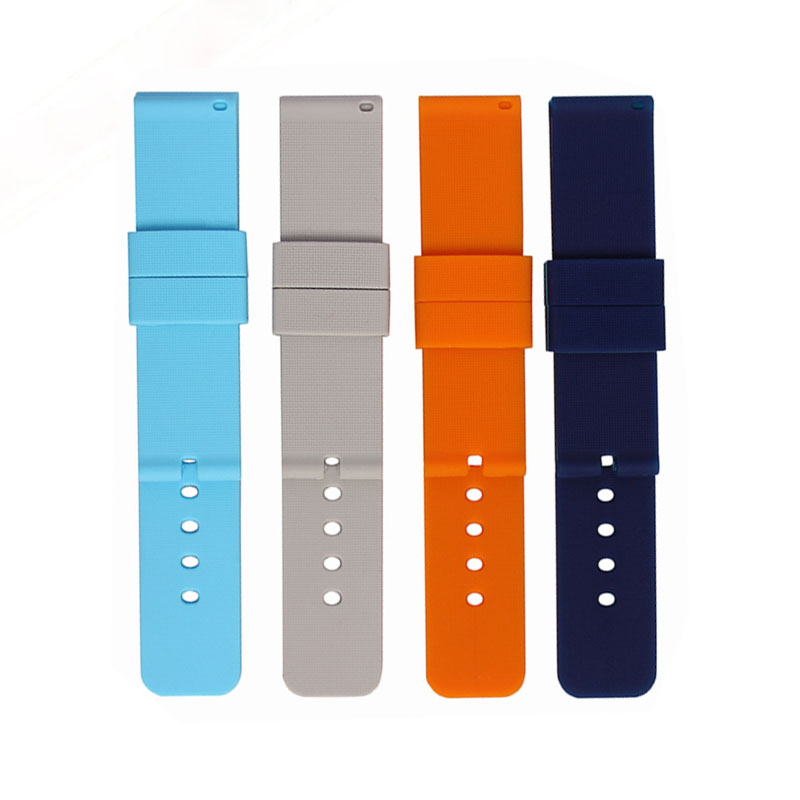Do silicone watch bands crack around the edges after prolonged wear?
Release Time : 2025-10-01
Silicone watch bands are the closest connection many people have to their smart devices. They fit snugly on the wrist, recording heart rate, steps, and sleep patterns day after day, witnessing moments of sweat during exercise, and accompanying the mundane rhythm of daily commutes. Soft, lightweight, and water-resistant—these advantages make them an ideal choice for both sports and everyday wear. However, with prolonged use, a subtle yet noticeable problem emerges: tiny cracks appear along the edges of the band, like the marks of time.
This cracking phenomenon isn't caused by a single factor, but rather by a combination of material properties, usage habits, and environmental factors. Silicone itself is a high-polymer material with good elasticity and chemical stability. High-quality liquid platinum silicone is smooth, has strong anti-aging properties, and can recover its original shape even after prolonged stretching. However, any material experiences fatigue under continuous stress. The edges of the band are the most stressed area—the tugging when putting it on, the bending when fastening the clasp, and the repeated friction during exercise all constantly test the material's limits. Especially around the connection point between the band and the watch case and around the buckle, the structural changes make it more prone to microscopic damage, which eventually manifests as visible cracks.
Environmental factors further accelerate this process. Ultraviolet rays in sunlight have a strong degrading effect; prolonged exposure can break down the silicone's molecular chains, causing the material to harden and lose elasticity. High temperatures in summer exacerbate this aging, while low temperatures in winter temporarily make the silicone brittle, making it more prone to cracking when subjected to external force. Salt, oil, and chemicals from sweat, skincare products, and sunscreen can also penetrate the surface of the band, accumulating over time and damaging the surface structure, making it rough, sticky, and less resistant to cracking.
Cleaning methods also affect the lifespan of the band. Frequent wiping with alcohol or strong cleaners can kill bacteria and remove dirt, but it can also corrode the silicone surface and damage its protective layer. Wearing the band while still damp after cleaning promotes microbial growth, further weakening the material. Furthermore, the tightness of the strap is crucial—a strap that is too tight is under constant high tension, accelerating wear and tear; while a strap that is too loose will slide and rub frequently during activity, causing localized wear.
It's worth noting that not all "cracks" indicate a quality issue. Slight changes in surface texture or very fine lines may be signs of natural aging from normal wear and tear, without affecting functionality. However, true structural cracks usually start from the edges and gradually extend inwards, potentially leading to the strap breaking. This is more common in low-quality silicone or poorly designed products, due to inferior material purity, uneven thickness distribution, and weaker stress resistance.
Ultimately, whether a silicone watch band will crack depends on the combination of material quality, usage, and maintenance. High-quality silicone watch bands, through optimized formulations and structural design, can significantly slow down the aging process. Users can also extend the lifespan by avoiding prolonged sun exposure, regularly cleaning gently, keeping it dry, and wearing it appropriately. When a watch band eventually shows signs of wear, it carries not only the passage of time, but also countless cherished memories. Its cracks may be the truest testament to its enduring companionship.
This cracking phenomenon isn't caused by a single factor, but rather by a combination of material properties, usage habits, and environmental factors. Silicone itself is a high-polymer material with good elasticity and chemical stability. High-quality liquid platinum silicone is smooth, has strong anti-aging properties, and can recover its original shape even after prolonged stretching. However, any material experiences fatigue under continuous stress. The edges of the band are the most stressed area—the tugging when putting it on, the bending when fastening the clasp, and the repeated friction during exercise all constantly test the material's limits. Especially around the connection point between the band and the watch case and around the buckle, the structural changes make it more prone to microscopic damage, which eventually manifests as visible cracks.
Environmental factors further accelerate this process. Ultraviolet rays in sunlight have a strong degrading effect; prolonged exposure can break down the silicone's molecular chains, causing the material to harden and lose elasticity. High temperatures in summer exacerbate this aging, while low temperatures in winter temporarily make the silicone brittle, making it more prone to cracking when subjected to external force. Salt, oil, and chemicals from sweat, skincare products, and sunscreen can also penetrate the surface of the band, accumulating over time and damaging the surface structure, making it rough, sticky, and less resistant to cracking.
Cleaning methods also affect the lifespan of the band. Frequent wiping with alcohol or strong cleaners can kill bacteria and remove dirt, but it can also corrode the silicone surface and damage its protective layer. Wearing the band while still damp after cleaning promotes microbial growth, further weakening the material. Furthermore, the tightness of the strap is crucial—a strap that is too tight is under constant high tension, accelerating wear and tear; while a strap that is too loose will slide and rub frequently during activity, causing localized wear.
It's worth noting that not all "cracks" indicate a quality issue. Slight changes in surface texture or very fine lines may be signs of natural aging from normal wear and tear, without affecting functionality. However, true structural cracks usually start from the edges and gradually extend inwards, potentially leading to the strap breaking. This is more common in low-quality silicone or poorly designed products, due to inferior material purity, uneven thickness distribution, and weaker stress resistance.
Ultimately, whether a silicone watch band will crack depends on the combination of material quality, usage, and maintenance. High-quality silicone watch bands, through optimized formulations and structural design, can significantly slow down the aging process. Users can also extend the lifespan by avoiding prolonged sun exposure, regularly cleaning gently, keeping it dry, and wearing it appropriately. When a watch band eventually shows signs of wear, it carries not only the passage of time, but also countless cherished memories. Its cracks may be the truest testament to its enduring companionship.







